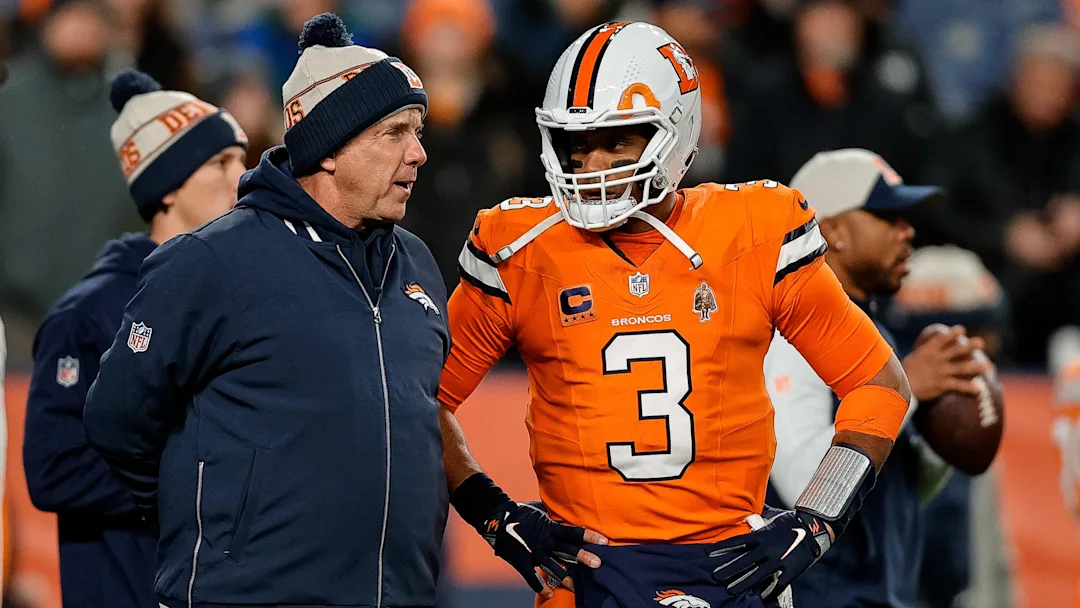The NFL world has been set ablaze by a new report revealing that former Seattle Seahawks quarterback Russell Wilson sought a jaw-dropping $350 million from the Denver Broncos during contract negotiations. This revelation has sent shockwaves across the league, raising major questions about player valuation, quarterback market inflation, and Wilson’s declining performance since joining Denver. As fans, analysts, and insiders digest the news, the debate has only intensified—was Russell Wilson worth that much, and how did his lofty demand ultimately shape the Broncos’ current trajectory?
When the Denver Broncos orchestrated a blockbuster trade to acquire Russell Wilson from the Seahawks, the move was heralded as a franchise-altering decision. Denver had struggled for years to find a stable quarterback after Peyton Manning’s retirement, enduring a carousel of subpar performances from numerous signal-callers. Bringing in Wilson, a Super Bowl champion and perennial Pro Bowler, was supposed to restore the team to relevancy and contention. The cost was steep—multiple first-round picks, a handful of key players, and a massive financial commitment—but the Broncos were desperate for a savior under center.
Behind the scenes, however, tensions were already simmering. According to the new report, Wilson and his representatives were not merely satisfied with the trade itself—they came to Denver seeking a contract that would reshape the quarterback salary landscape. The number reportedly floated: $350 million. That kind of demand would have shattered all previous NFL records, vaulting Wilson into a new stratosphere of quarterback compensation. The figure shocked team officials and raised red flags internally about the long-term sustainability of such a deal, especially for a player entering his 30s and coming off a somewhat inconsistent season in Seattle.
Despite initial optimism, the Broncos’ relationship with Wilson quickly grew complicated. On the field, expectations rapidly turned to frustration. What was supposed to be a high-octane offense led by an elite veteran quarterback became one of the most anemic units in the league. Wilson’s numbers plummeted. He struggled with accuracy, pocket presence, and timing. Worse, he failed to establish chemistry with his new receivers and seemed out of sync with then-head coach Nathaniel Hackett’s system. The Broncos’ offense was unrecognizable from the explosive unit fans had hoped for, and the team plummeted in the standings.
Off the field, whispers of locker room discord and preferential treatment began to leak. Wilson’s leadership style, once considered one of his strengths, came under fire. Reports surfaced of his personal team having special access to team facilities, of players resenting his seemingly protected status, and of a rift between him and key members of the organization. Combine that with the newly revealed $350 million demand, and a picture begins to emerge of a star whose self-perception may have outpaced his current production.
The revelation of Wilson’s massive asking price has also rekindled conversations about the state of quarterback salaries in the NFL. In a league that increasingly prioritizes quarterback play, contracts have ballooned over the past decade. From Patrick Mahomes’ $450 million megadeal to Joe Burrow and Justin Herbert each crossing the $50 million per year threshold, the financial arms race at the position shows no signs of slowing. Wilson likely saw himself as belonging in that elite tier—especially given his resume, accolades, and marketability. But as the Broncos learned, paying for past performance is a risky endeavor, especially when the return on investment is uncertain.
Ultimately, Denver did sign Wilson to a five-year, $245 million extension shortly after acquiring him, with $165 million guaranteed. At the time, the deal was one of the largest in NFL history. But even that staggering contract now seems mild compared to the reported $350 million figure. The extension was meant to solidify the Broncos’ future, yet it quickly became an albatross as Wilson underperformed and the team floundered. Less than two years later, Denver benched Wilson, cut ties with head coach Hackett, and hit the reset button on their entire offensive philosophy under new head coach Sean Payton.
Now, with Wilson gone and the Broncos still reeling from the fallout, the news of his original demand only adds insult to injury for fans. Many are left wondering: was this a case of unrealistic self-valuation, or simply a calculated move that backfired? Did the Broncos cave too easily in contract talks, or was the damage already done by the time pen hit paper? Some argue that Denver should have known better than to give Wilson that kind of leverage in the first place. Others point to a front office desperate for a quick fix, blinded by star power and championship dreams.
Meanwhile, Wilson has moved on, now with the Pittsburgh Steelers in a presumed mentorship and bridge role. His career is at a crossroads. Whether he can recapture the magic of his early years remains to be seen, but his reputation has undoubtedly taken a hit. The $350 million figure, now public, will follow him in every conversation about his career, his ego, and his legacy. For a quarterback once viewed as humble and hungry, the optics of such a massive demand—juxtaposed against his Denver downfall—paint a more complex, perhaps even damning portrait.
The ripple effects of the Wilson saga will be felt in Denver for years. The franchise mortgaged its future to acquire him, only to see the plan unravel almost immediately. The salary cap ramifications of his deal will linger, and the lost draft capital delayed the rebuild. Sean Payton now faces the unenviable task of cleaning up the mess while trying to instill a new culture and find a quarterback who can truly lead the team forward.
For the rest of the NFL, Wilson’s story serves as both a cautionary tale and a benchmark. It underscores the dangers of investing too heavily in name recognition over recent performance. It also illustrates how quickly the narrative can shift around even the most decorated veterans. In the span of just a few seasons, Wilson went from being one of the league’s most admired quarterbacks to a symbol of overreach and unmet expectations.
As for fans, the $350 million demand feels like a gut punch. In a league where every dollar matters under the salary cap, such a figure seems almost fantastical—especially considering how poorly things turned out. The report adds another layer of disappointment to what was already one of the most disastrous quarterback acquisitions in recent NFL history. And it raises a broader question: how do teams evaluate leadership, fit, and long-term value in a league driven by urgency and pressure?
Russell Wilson will always have his Super Bowl ring, his Pro Bowl nods, and his place in Seahawks history. But in Denver, his legacy is marked by what could have been—and now, by what he apparently believed he deserved. The $350 million number will be debated, dissected, and discussed endlessly, but perhaps the most telling part of the story is what it reveals about the modern NFL: a league where the stakes have never been higher, the margins for error are razor-thin, and the gap between perception and reality can cost a franchise everything.



